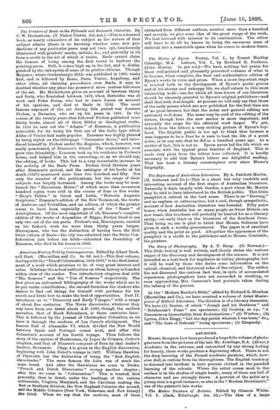American History Told by Contemporaries. Edited by Albert Bush- nell
Hart. (Macmillan and Co. 8s. 6d. net.)—This first volume, dealing with the "Era of Colonisation, 1492-1689," is the first instal- ment of a work which promises to be of very great interest and value. It brings the actual authorities on whom history is founded within view of the reader. Two introductory chapters deal with " The Sources " and the " Use of Sources " respectively. The first gives an epitomised bibliography of the works which are to be put under contribution; the second furnishes the student who desires to find out things for himself with guidance for his search and hints how to make the best of opportunities. Part II. introduces us to "Discovery and Early Voyages," with a range of about five centuries. The Norse discoveries, whatever they may have been, are dated about A.D. 1000, though the earliest narrative, that of Hauk Erlendsson, is three centuries later. This is followed by the journal of Christopher Columbus, as we have it through the medium of Las Casas's abridgment. The famous Bull of Alexander VI. which divided the New World between Spain and Portugal comes next, and after this Columbus's account of his fourth voyage. Then follows the story of the capture of Montezuma, by Lopez de 616mara, Cortes'a chaplain, and that of Pizarro's conquest of Peru by that leader's brother, Hernando. Chap. 4 is given to the English discoveries, beginning with John Cabot's voyage in 1497. William Hawkins of Plymouth has the distinction of being the " first English slave-trader." The more famous Sir John was of much the same breed. And after the Hawkinses we come to Drake. "French and Dutch Discoveries" occupy another chapter ; after this we come to " Colonisation." This is treated, first generally, then in detail, under the headings of the various settlements, Virginia, Maryland, and the Carolinas making the Bret or Southern division, the New England Colonies the second, and the Middle Colonies (New York, Delaware, and New Jersey) the third. When we say that the sections, most of them extracted from different authors, number more than a hundred and seventy, we give some idea of the great range of the work. We look forward with interest to its continuation. The editor will have to do all he knows to bring the enormous mass of material into a reasonable space when he comes to modern times.


































 Previous page
Previous page